|
|

with photos by Robert Wincup
During April 1998 John Harris, John Oates, Robert Wincup and myself were fortunate to spend two weeks in eastern Texas. Only J.O. had ever visited the States before, so for the rest of us the sheer volume of species available was mind-blowing. For the first nine days of the holiday we travelled over 2,000 miles visiting such exciting places as the Rio Grande Valley and the Edward’s Plateau, seeing quality species such as Whooping Crane, Black-capped Vireos, Golden-cheeked Warbler and Tropical Parula. Although we were all really looking forward to visiting High Island in anticipation of seeing such stunning species as Chestnut-sided Warbler, Northern Parula and Magnolia Warbler, species that would be difficult to encounter anywhere else in Texas.
April
13
The early part of the morning was spent at the W.G. Jones State Forest near
Houston. Here we saw the two remaining woodpeckers that we had failed to see
the previous evening: i.e. Red-cockaded and Red-headed. From here we began
to travel the 150km towards the coast, and enter the famous High Island area
of Texas. A heavy downpour and thick fog greeted our arrival. This raised
our spirits and expectations even higher. Our first visit was to Boy Scout
Wood which is undoubtedly the best of the three High Island Woods all of which
are run by the Houston Audubon Society. Entrance to each wood is two dollars
a day, although we chose to purchase a twenty dollar pass, which entitles
you to unlimited access to all three woods for one year. As a kind of permit
the society gives you an embroidered patch, the 1998 version featured a Magnolia
Warbler.
Boy Scout Wood covers an area of 51 acres, although the best part is only the size of Leathes Ham and covered in boardwalks. These boardwalks are always full of birdwatchers, the American ones being very colourful and vocal. Despite this the birds are very tolerant and surprisingly showy. The lunchtime heavy rain had obviously produced a mini fall, as birds were everywhere, Brown Thrashers, Ovenbirds, Kentucky Warblers and Wood Thrushes were present and, as expected, kept in close proximity to the ground. Eighteen Orchard Orioles were seen in the surrounding trees, amazingly one of seven species of Oriole seen during the holiday. Warblers were abundant and were represented by Worm-eating, Common Yellowthroat, Prothonotary, Orange-crowned, Parula, Cerulean, Blue- winged, Kentucky, Hooded, Magnolia, Ovenbirds and Northern Waterthrush.
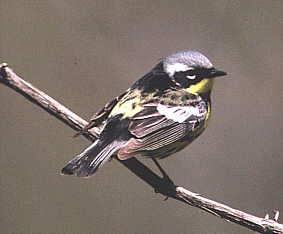 Magnolia Warbler
Magnolia Warbler
Birds were everywhere with Vireos present including Solitary, Red-eyed, Warbling and White-eyed. It was difficult to know what to look at next as species new to me were appearing in every bush and tree. Grey Catbirds were frequently seen alongside White-throated Sparrows and Indigo Buntings. Completing the picture were the occasional Scarlet and Summer Tanagers, Ruby-crowned Kinglet, Acadian Flycatcher, Green Heron and Carolina Wren. A super start to our visit to High Island and just think, all these seen in a wood the size of Leathes Ham. What will tomorrow bring?
April
14
An early morning visit to the Anahvac National Wildlife Park was most productive,
producing a totally different selection of birds to Boy Scout. This area is
similar to Minsmere but here you can find some good birds, with the added
bonus of no teashop! We did remarkably well here and like many American reserves
it is possible to do your birdwatching from a car (definitely suited to the
lounge lizards). Species noted included five each of Least and American Bitterns,
seen in both flight and on the ground. Boat-tailed Grackles are the speciality
for this area - and also one of the drabbest - we managed to see up to 20.
The King Rail we saw later wasn’t far behind when it came to dress sense,
although this was a new bird for all of us including J.O.
Much more impressive were the waterbirds with three Fulvous Whistling ducks and an American Purple Gallinule being the highlights. Also ticked off here was Swamp Sparrow, nine Eastern Kingbirds, Marsh Wren, up to four Savannah Sparrows and ten Tree Swallows.
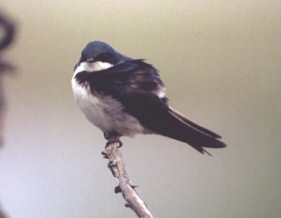 Tree Swallow
Tree Swallow
We then travelled on to Smith Oak Wood, this is larger than Boy Scout and much harder to work. Here we picked up White-throated Sparrow, Wood Thrush, Blue Jays, Eastern Kingbird and two stunning Indigo Buntings. From here we ventured south towards Bolivar Flats, although when we arrived at midday it was low tide and a heat haze hung around. However, the number of waders and terns made up for the initial disappointment and the flats looked impressive against the distant skyscrapers of Galveston. An important species here is Piping Plover, which feeds on the sandy shore and is one of America’s rarest waders, we were lucky to see four alongside both Snowy and Wilson’s Plover. Other birds identified on the mudflats were Willet, Wilson’s Phalarope (flying over), up to four Semi-palmated Plovers and Marbled Godwits and fifty American Avocets. A brief stop at Rollover Pass produced a summer-plumaged Bonaparte’s Gull amongst a group of about fifty Laughing Gulls in the car park, our first of the trip. A group of eight Olivaceous Cormorants were found swimming in the nearby river, a species we had previously struggled to find in Texas.
We then couldn’t resist the temptation of returning to Boy Scout Wood to see what had turned up. A quick look at the information board revealed nothing mega but a Rose-breasted Grosbeak was new and what a stunner. A Magnolia Warbler in full summer plumage was the cream of the crop of the eight species of warbler present. Other gems on view were Summer and Scarlet Tanagers, Solitary and Warbling Vireos and five Grey Catbirds.
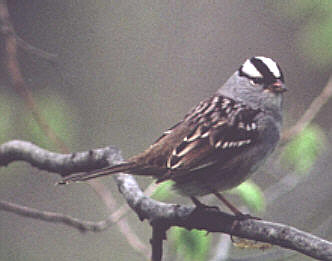 White-crowned Sparrow
White-crowned Sparrow
April
15
First stop of the day was some flooded fields at Pear Orchard which held a
nice variety of waders, sandpipers included Solitary, Spotted, twenty-five
Pectorals, two Least and a single Stilt. A Flock of eighty Lesser and ten
Greater Yellowlegs were mixed in with the American race Whimbrels N.p.hudsonicus,
Willet, Motlled Duck, copious White Ibis and Long-billed Curlew also added
to the show.
A decision was taken to return to Anahuac to look for a rather drab but distinctive nearctic sparrow, the Seaside Sparrow. Two males were easily found, although more impressive were a flock of about two hundred and fifty Tree Swallows seen resting on an adjacent wire fence. We then returned to Boy Scout Wood , and boy was it worth it. New species included Great-crested Flycatcher, Lincoln’s Sparrow, Swainson’s Thrush and Downy Woodpecker. A repeat visit to Smith Oaks turned up an excellent array of species including my star bird of the trip a Black-throated Green Warbler. This species always looks immaculate in contrast to the Yellow Warblers present, which normally appeared a wee bit tatty. A superb Yellow-billed Cuckoo was ’scoped at this site, my first of the trip. The Smith Oaks heron colony is always worth a visit, we had excellent views of a number of heron and ibis species as well as Anhinga and Olivaceous Cormorants.
Another wood visited called Eubanks (was Chris at home? – Eds) produced an attractive, though difficult to see female Chestnut-sided Warbler as it flitted high in the tree canopy, a new species for the group. News then came of a Black Noddy, seen earlier in the afternoon a few kilometres away at Rollover Pass. As this was only the second record for Texas, we just had to go and what an addition to the holiday list. Yes, you’re right we missed it, arriving in the failing light the damned thing had flown off, which keeps alive my now-legendary record with seabirds, even in the New World (bravo- Eds). To make up for this travesty of justice we were rewarded with a flock of four hundred Blue - winged Teal, thirty Forster’s and one hundred and fifty Royal Terns, absolute rubbish!
April
16
Back to Boy Scout Wood, the day opened with Tennesse, Hooded, Kentucky, Yellowthroat,
Blue-winged, Cerulean, Black-throated Green, Black and White, Parula Warblers,
Ovenbird and Yellow-breasted Chat, not a bad list. Added to this a Lesser
Nighthawk was seen roosting in a totally bare tree was identified by its buff
primary wing patch, and faintly barred buff underparts. This bird was considered
to be a Common Nighthawk when first found until John Dunn the tour leader
of a Sunbirder group reidentified it.
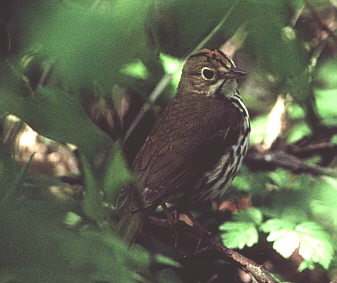 Ovenbird
Ovenbird
Near the back of the wood is an area of rough grassland with scattered trees, which is favoured by Indigo Buntings and Blue Grosbeaks. A number of Buntings were easily located and after some searching we eventually found a pair of Grosbeaks in close association with a very bright male Painted Bunting. From here we moved on, heading for Smith Oaks. A short stop here produced our first sighting of a Western Tanager, a superb male, a very unusual species for eastern Texas. Other highlights included a Yellow-billed Cuckoo, Rose-breasted Grosbeak and Swainson’s Thrush. It’s strange how many American bird names have a hyphen in the middle, especially when you’re typing.
On Route 65 between Stowell and Anahuac lay the Winney ricefields we visited these in the hope of seeing a reported Mountain Plover. Although we could not find the bird, the area did host a variety of waders which was a pleasant surprise. Two Long-billed Dowitchers were present the only ones on the whole trip with which we were really happy, separation from Short-billed proved to be a major headache. A Wilson’s Snipe was seen and other highlights included fifteen American Golden Plover, Pectoral and Solitary Sandpiper, seventy five Lesser Yellowlegs mixed in with Willet, Whimbrel and White Ibis.
Late afternoon and early evening was spent around Anahuac National Wildlife Refuge here we managed to add two new birds to our list, the first one an immature Yellow-crowned Night Heron the other a flock of five Dickcissel. To round off the evening we had sightings of American Purple Gallinule and American Bittern, three of each which was nice, Blue Grosbeak and Eastern Meadowlark. At dusk a Lesser Nighthawk was found hawking for insects over the marsh. This individual was clearly a Lesser as it had rounded wingtips, although the books state that they do not appear that far north in Texas.
April
17
The morning was spent at Bolivar Flats, this proved to be far more eventful
than we would have expected. The intention was to look for Clapper Rail and
Sharp-tailed Sparrow but this was quickly curtailed when it was realised we
had locked the keys inside the car. To cut a long story short, JH and myself
managed to find a local garage and enlist the help of the Texas equivalent
of the AA, which consisted of a battered wrecker truck with no doors and a
driver with no teeth. So after a wasted two hours and our pockets being fifty
dollars lighter we were mobile again.
During the now-brief search of the flats we managed to tick off a party of four Black Skimmers, over one thousand American Avocet, a large mixed flock of Royal and Least Terns consisting of around seven hundred birds and two Shore Larks. While standing on the beach talking to two local birdwatchers a small passerine was observed coming in off the sea and flying straight into their camper van. To everyone’s amazement it proved to be a male Yellowthroat, it was soon caught and released flying off inland.
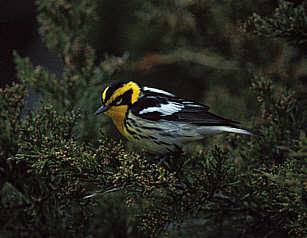 Blackburnian Warbler
Blackburnian Warbler
The weather conditions were now looking ideal for a fall of migrants, the winds were picking up and the skies darkening. We decided to head back to High Island, our visit to Smith Oaks was reasonable but uninspiring, three Swainson’s Thrushes, single Wood Thrush and Grey Catbird, Brown Thrasher, Ruby-crowned Kinglet, Orchard and Baltimore Oriole. By the time we reached Boy Scout Wood the occasional shower had developed which produced a decent fall of migrants. An outstanding male Blackburnian Warbler was a new tick and so was a - although somewhat rarer - Lawrence’s Warbler a beautiful male. This is similar to a male Golden-winged Warbler but with all yellow underparts and is, in fact, a hybrid between Golden-winged and Blue-winged Warbler. Other goodies flitting around were three Tennessee, two Blue-winged, two Black-throated Green, three Parula, two Kentucky, three Hooded, two Yellow, three Black and White and one male Chestnut-sided Warbler. A male Western Tanager was a good bird for eastern Texas, other goodies bought in by the weather front was a Whip-poor-will seen very well as it roosted in a dead tree in open sunlight, a Great-crested Flycatcher, Philadelphia and Yellow-throated Vireo, Inca Dove and Swainson’s Thrush.
April
18
Our final morning in Texas was spent at Boy Scout Wood, birds seen were similar
to the previous day but two Cerulean Warblers performed extremely well and
unusually for this species low down in foliage. The male Chestnut-sided Warbler
was still present giving good views to the assembled mass. Several Vireos
were on show including Philadelphia. Red-eyed, Yellow-throated, Solitary and
White-eyed. Other gems included Acadian Flycatcher, Rose-breasted Grosbeak,
Ruby-crowned Kinglet, Yellow and Parula Warbler. Then the heavens really opened,
unfortunately for us we had to make our way to the airport. We can only wonder
what had turned up with the torrential rain at High Island, but maybe it’s
best we didn’t know. I had enjoyed the holiday spent in the company of good
friends and a bird ticked off in the book is worth a lot of maybes.
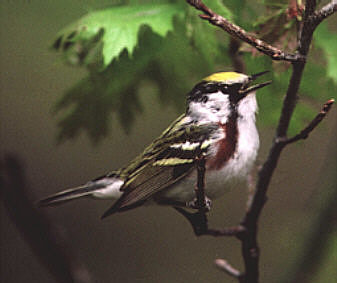 Chestnut-sided Warbler
Chestnut-sided Warbler
Other
holiday reports:
Report on a birding holiday to Eilat in Israel in Spring
1997 - with photographs
Report of a birding holiday to Beidaihe, China in
May 1997 - with photographs